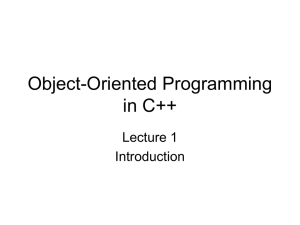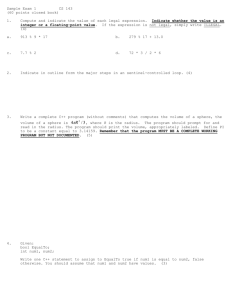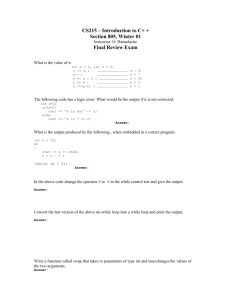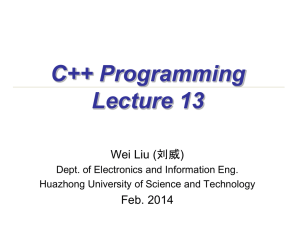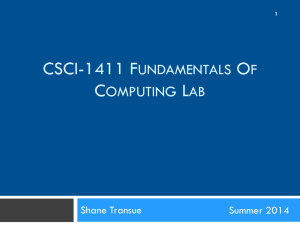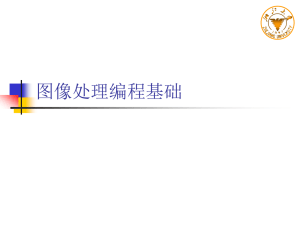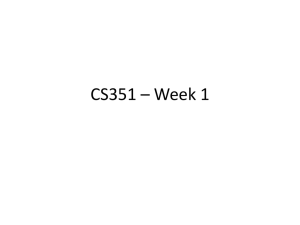Lectures 9, 10, 11 functions. Answers to Exercises. Microsoft Word
advertisement
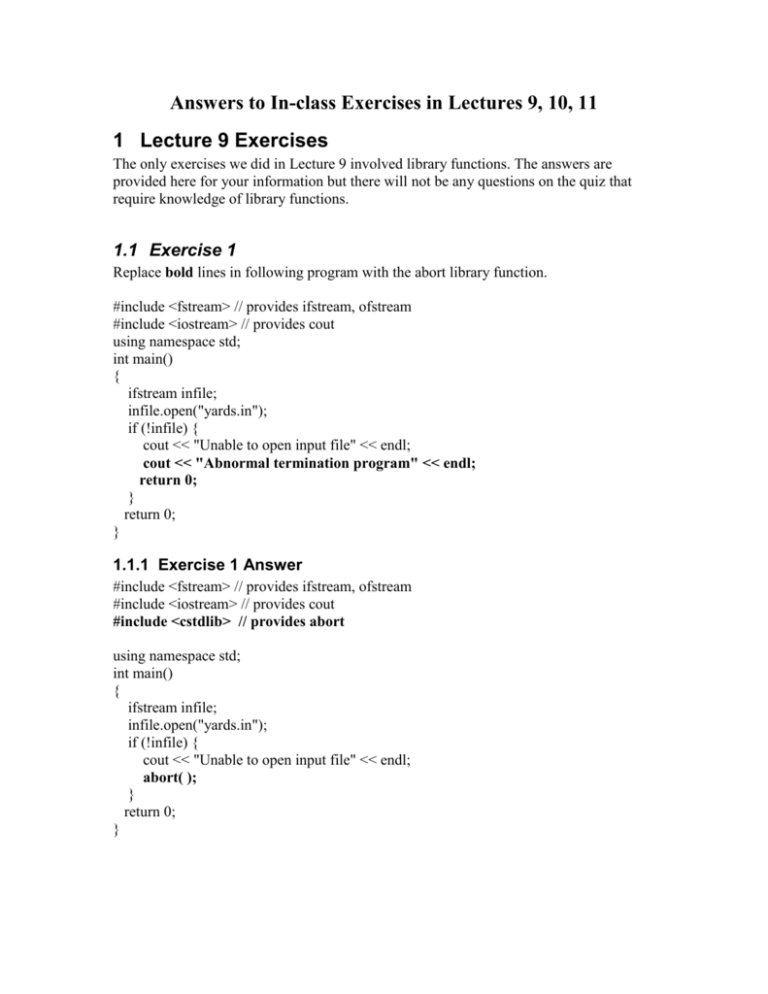
Answers to In-class Exercises in Lectures 9, 10, 11
1 Lecture 9 Exercises
The only exercises we did in Lecture 9 involved library functions. The answers are
provided here for your information but there will not be any questions on the quiz that
require knowledge of library functions.
1.1 Exercise 1
Replace bold lines in following program with the abort library function.
#include <fstream> // provides ifstream, ofstream
#include <iostream> // provides cout
using namespace std;
int main()
{
ifstream infile;
infile.open("yards.in");
if (!infile) {
cout << "Unable to open input file" << endl;
cout << "Abnormal termination program" << endl;
return 0;
}
return 0;
}
1.1.1 Exercise 1 Answer
#include <fstream> // provides ifstream, ofstream
#include <iostream> // provides cout
#include <cstdlib> // provides abort
using namespace std;
int main()
{
ifstream infile;
infile.open("yards.in");
if (!infile) {
cout << "Unable to open input file" << endl;
abort( );
}
return 0;
}
1.2 Exercise 2
Write a code segment to generate and display 5 random numbers between 0 and 1000.
assume srand has already been called with the current time to properly initialize the
random generator
1.2.1 Exercise 2 Answer
int randomNumber ;
for (int i = 1 ; i <= 5 ; i++) {
randomNumber = (float) rand ( ) /RAND_MAX * 1000;
cout << randomNumber << endl;
}
2 Lecture 10 Exercises
2.1 Exercise 1
1) write a function which accepts an integer value as input, and returns an integer which
is the cube of that input.
y
Cube
int y 3
int
2.1.1 Exercise 1 answer
int Cube (int y) {
return y * y * y ;
}
2.2 Exercise 2
Write a function that accepts a char as input and returns true if the char is a digit from 0
to 9 or false if the character is not a digit from 0 to 9.
ch
char
IsDigit
2.2.1 Exercise 2 Answer
bool IsDigit (char ch)
{
if ((ch >= ‘0’) && (ch <= ‘9’))
return true;
else
return false;
}
bool true if ch is 0 to 9
false if ch is not 0 to 9
2.3 Exercise 3
Write a main function that calls the Cube function from exercise 1. Have it calculate the
cube of the numbers from 1 to 10 and display them. int Cube (int y)
2.3.1 Exercise 3 Answer
int Cube (int y);
//function prototype
int main ()
{
for (int i = 1; i <= 10; i++) {
cout << i << “ cubed is” << Cube (y) << endl;
}
return 0;
}
2.4 Exercise 4
Write a main function that calls the IsDigit function from Exercise 2. Have it read in 10
input characters from a user and for each one, display whether it is a digit or not.
bool IsDigit (char ch); // function prototype
2.4.1 Exercise 4 Answer
bool IsDigit (char ch);
// function prototype
int main ( )
{
char inputChar;
for (int i = 1; i <= 10; i++) {
cout << “Enter character: “;
cin >> inputChar;
if (IsDigit (inputChar))
cout << inputChar << “ is a digit” << endl;
else
cout << inputChar << “ is not a digit” << endl;
}
return 0;
}
2.5 Exercise 5
Write a function named Smallest that takes three integer inputs and returns an integer that
is the smallest of the three inputs. Write the prototype for the Smallest function. Write a
program that gets 3 integers from a user and displays the smallest.
2.5.1 Exercise 5 Answer
#include <iostream>
using namespace std;
int Smallest (int a, int b, int c);
// function prototype
int main () {
int x, y, z;
cout << “Enter three integers ”;
cin >> x >> y >> z;
cout << “The smallest integer is: ” << Smallest (x, y, z) << endl;
return 0;
}
int Smallest (int a, int b, int c) {
int smallest = a;
if (smallest > b)
smallest = b;
if (smallest > c)
smallest = c;
return smallest;
}
2.6 Exercise 6
Write a function that, given a letter of the alphabet, returns true if the letter is a vowel
(lower or uppercase) and returns false if the letter is not a vowel.
letter
(char)
IsAVowel
true if letter is a vowel
false if letter is not a vowel
Also write the prototype for IsAVowel.
Write a program to invoke the IsAVowel function. Inputs a letter and prints out whether
it is or is not a vowel.
2.6.1 Exercise 6 Answer
#include <iostream>
using namespace std;
bool IsAVowel (char);
//function prototype
int main ( ) {
char ch;
cout << “Enter a letter: “ ;
cin >> ch ;
if (IsAVowel (ch))
cout << ch << “ is a vowel “ << endl;
else
cout << ch << “ is not a vowel “ << endl;
return 0;
}
bool IsAVowel (char ch) {
switch (ch) {
case ‘a’: case ‘A’: case ‘e’: case ‘E’: case ‘i’: case ‘I’:
case ‘o’: case ‘O’: case ‘u’: case ‘U’:
return true;
}
return false;
}
2.7 Exercise 7
1) Find the error in each of the following program segments and explain how to fix it.
a) int sum (int x, int y) {
int result;
result = x + y;
}
b) int sum (int n) {
if (0 == n)
return 0;
else
n = n + n;
}
c) in main program:
double x = 1E10;
cout << "square of 1E10 = " << square (x) << endl;
int square (int x)
return x * x;
}
{
2.7.1 Exercise 7 Answer
1a) result is a local variable. Calling function cannot use the result because it was never
returned. Add return statement.
int sum (int x, int y) {
int result;
result = x + y;
return result;
}
b) n is local parameter. The calling function’s parameter never changed. Add return
statement
int sum (int n)
{
if (0 == n)
return 0;
else
n = n + n;
return n;
}
c) in main program, x is data type double. It will be truncated when the square
function is invoked and incorrect values will be produced. Promotion rules were not
followed. Cannot safely convert double to integer. Fix by changing argument and
return value for Square function to data type double .
double x = 1E10;
cout << "square of 1E10 = " << square (x) << endl;
double square (double x)
return x * x;
}
{
2.8 Exercise 8
Find the error in the following function and fix it.
void displayErrorMessage (int errorNumber)
{
switch (errorNumber) {
case 0: cout << "Fatal Error!" << endl;
break;
case 1: cout << "Error!" << endl;
break;
default: cout << "Invalid error code" << endl;
}
return true;
}
2.8.1 Exercise 8 Answer
This function is defined with a void return value but we are returning a boolean constant.
Fix by replacing the return true; statement with a return; statement.
Find the error in the following function and fix it.
void displayErrorMessage (int errorNumber)
{
switch (errorNumber) {
case 0: cout << "Fatal Error!" << endl;
break;
case 1: cout << "Error!" << endl;
break;
default: cout << "Invalid error code" << endl;
}
return;
}
3 Lecture 11 Exercises
Change the GetMinAndMax function (see below) so that it validates the
user’s input. Only integers between 0 and 1000 are allowed
(including 0 and 1000).
If invalid input is detected, GetMinAndMax stops processing input and returns false to
the caller.
If GetMinAndMax successfully processes the input and calculates the minimum and
maximum values, it returns true to the caller.
int main() {
int minimum = 0, maximum = 0;
GetMinAndMax (minimum, maximum);
cout << "Minimum value is " << minimum << endl;
cout << "Maximum value is " << maximum << endl;
return 0;
}
void GetMinAndMax (int &min, int &max) {
int input;
min = INT_MAX;
max = INT_MIN;
for (int i = 0; i <= 5; i++) {
cout << “Enter an integer: “;
cin >> input;
if (min > input)
min = input;
if (max < input)
max = input;
}
}
3.1.1 Exercise 1 Answer
Change return type of GetMinAndMax to bool and add an if statement to validate the
input right after the cin statement.
int main() {
int minimum = 0, maximum = 0;
GetMinAndMax (minimum, maximum);
cout << "Minimum value is " << minimum << endl;
cout << "Maximum value is " << maximum << endl;
return 0;
}
bool GetMinAndMax (int &min, int &max) {
int input;
min = INT_MAX;
max = INT_MIN;
for (int i = 0; i <= 5; i++) {
cout << “Enter an integer: “;
cin >> input;
if ((input < 0) || (input > 1000))
return false;
if (min > input)
min = input;
if (max < input)
max = input;
}
}
3.2 Exercise 2
1) Change the main function so that it calls your new
version of GetMinAndMax properly
3.2.1 Exercise 2 Answer
Must check the bool return value before using the minimum and maximum values
returned. If the return value is false, these values are meaningless. Add an if statement to
the call to GetMinAndMax to make sure the values are meaningful before you display
them to the user.
bool GetMinAndMax (int &min, int &max); //function prototype
int main () {
int minimum = 0, int maximum = 0;
if ((GetMinAndMax (minimum, maximum)) {
cout << “Minimum value is “ << minimum << endl;
cout << “Maximum value is” << maximum << endl;
}
}
3.3 Exercise 3
Fix the error in the following program segment
void sum (int n) {
if (0 == n)
return 0;
else
n = n + n;
}
3.3.1 Exercise 3 Answer
n is a local variable. No information was passed back to the caller. Change n to a
reference parameter by adding &.
void sum (int & n) {
if (0 == n)
return 0;
else
n = n + n;
}
3.4 Exercise 4
3) Rewrite the following function prototype to return the result
as a parameter instead of as a return value
int Square (int y);
3.4.1 Exercise 4 Answer
Add a reference parameter called result and use that to pass the information back to the
calling function. Also change return type to void since nothing will be returned using the
return statement.
void Square (int y, int &result );
Exercise 5
Produce the documentation header for the GetMinAndMax
function
3.4.2 Exercise 5 Answer
/*
* GetMinAndMax – Reads in 5 integers from the user and returns the smallest and
*
largest value to the caller.
*
* Pre: Input parameters - none
*
Output parameters – int & min Will hold the smallest value when function returns
*
int & max will hold the largest value when the function returns
*
* Post: Return value – if true min contains the smallest value inputted from the user and
*
max contains the largest value.
*
if false min and max may not contain valid data
*
*/
3.5 Exercise 6
Write a C++ function that satisfies the following pre and post
conditions:
/*
* IsUppercase
*
* PRE: Input character ch. Function will determine if this
*
is an uppercase letter or not.
* POST: Return value true if input character ch is an upper
*
*
*
*/
case letter in the range A - Z.
false if input character ch is not an upper
case letter in the range A - Z.
3.5.1 Exercise 6 Answer
bool IsUppercase (char ch)
{
if ((ch >= ‘A’ ) && (ch <= ‘Z’))
return true;
else
return false;
}

